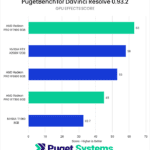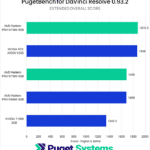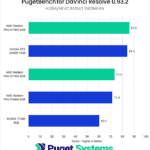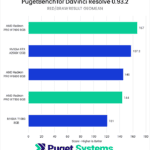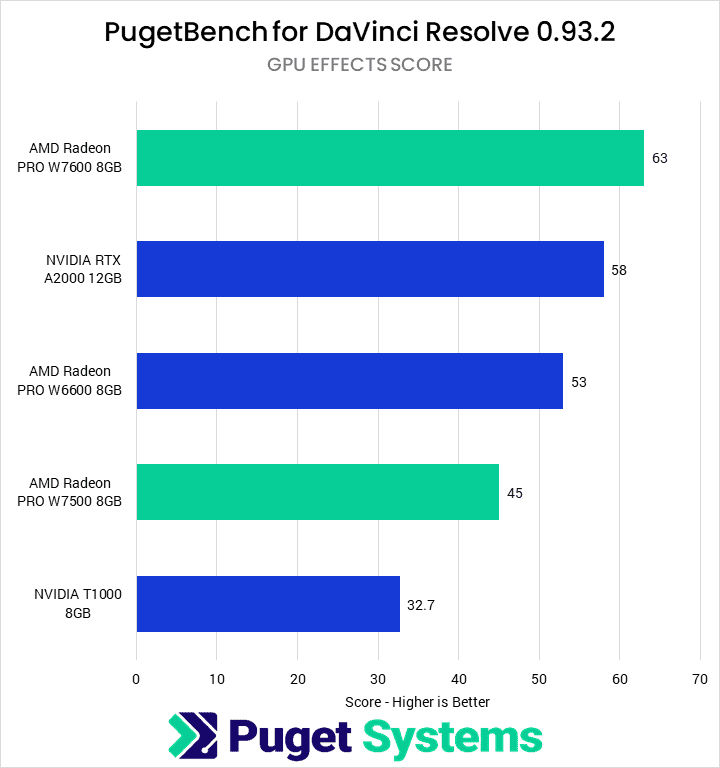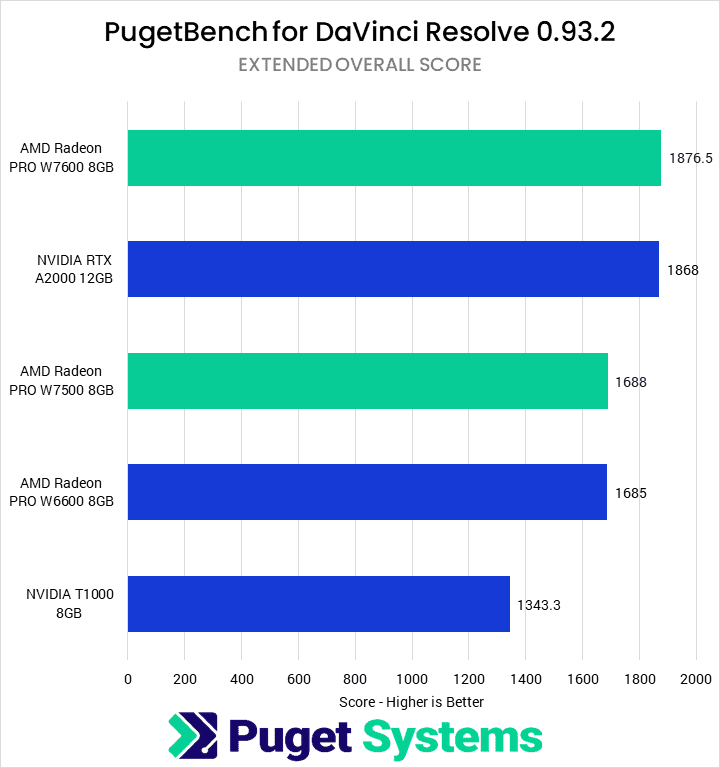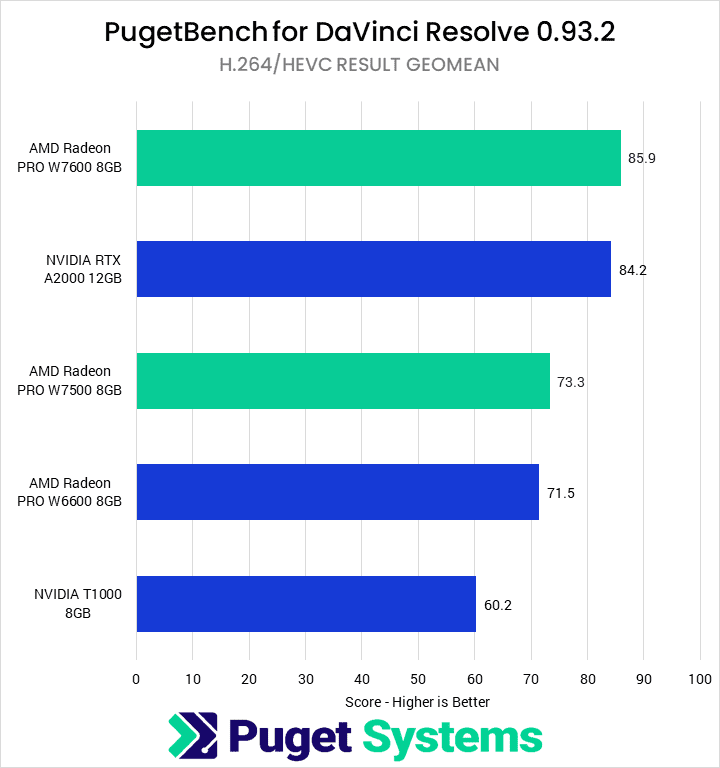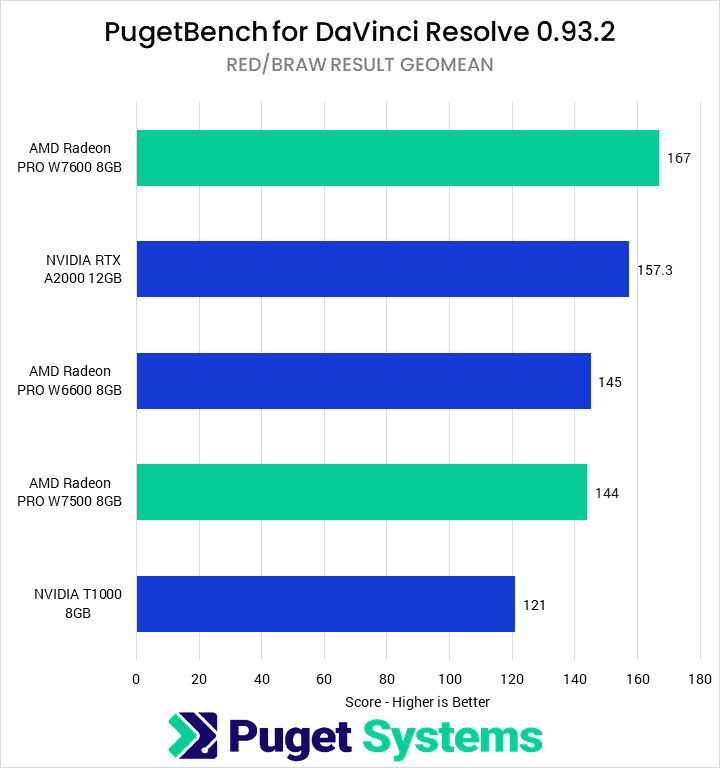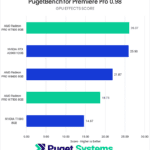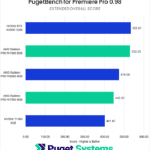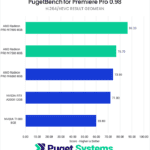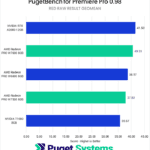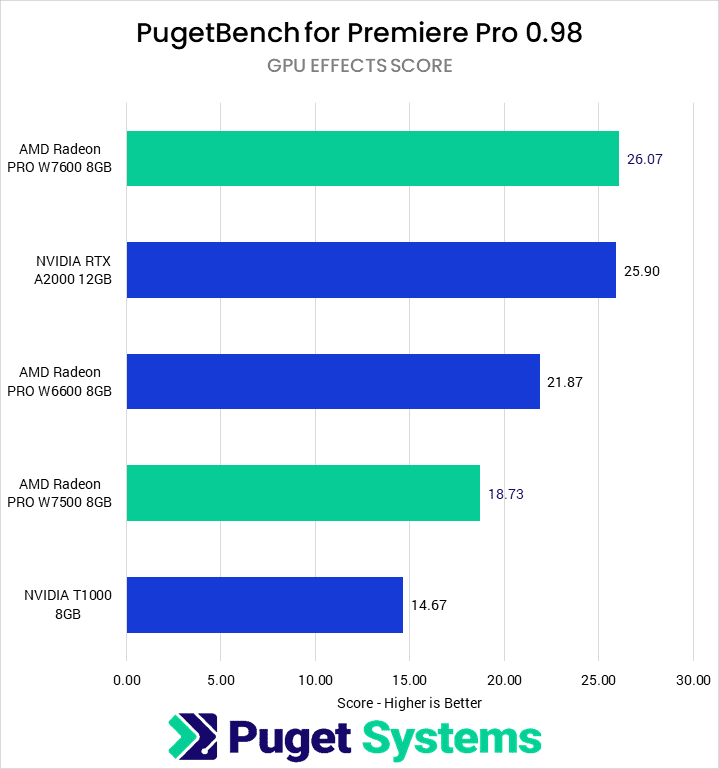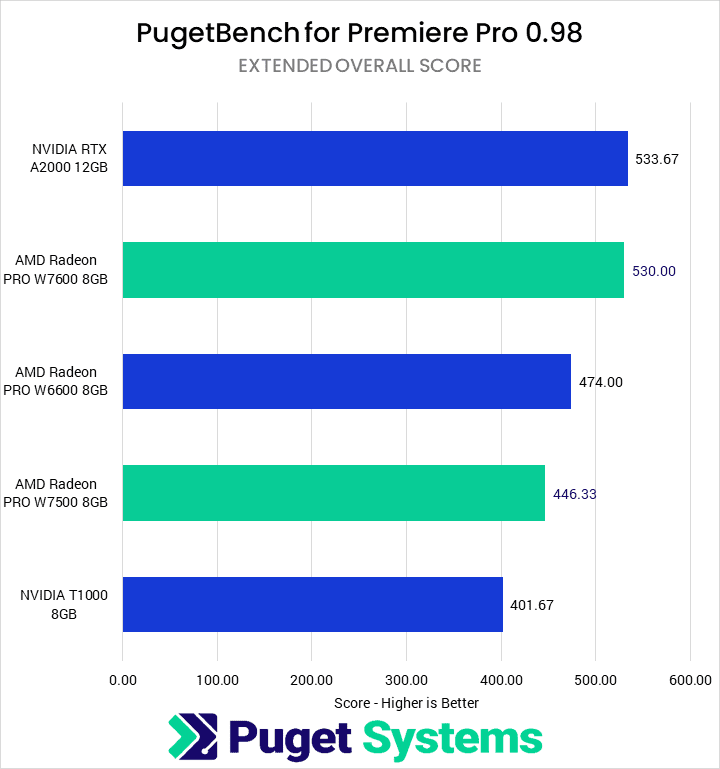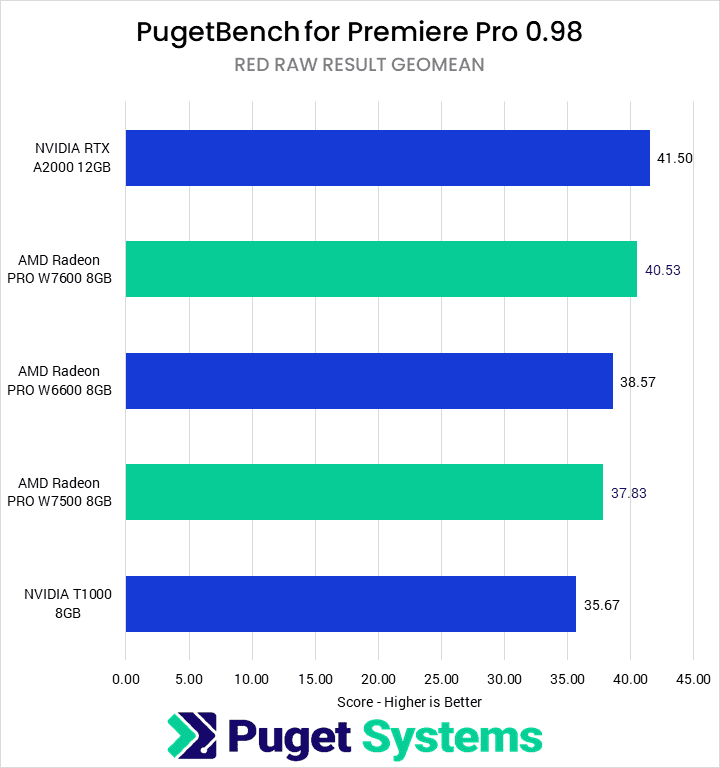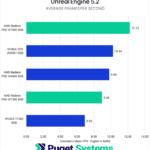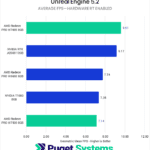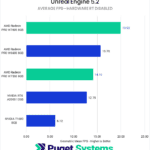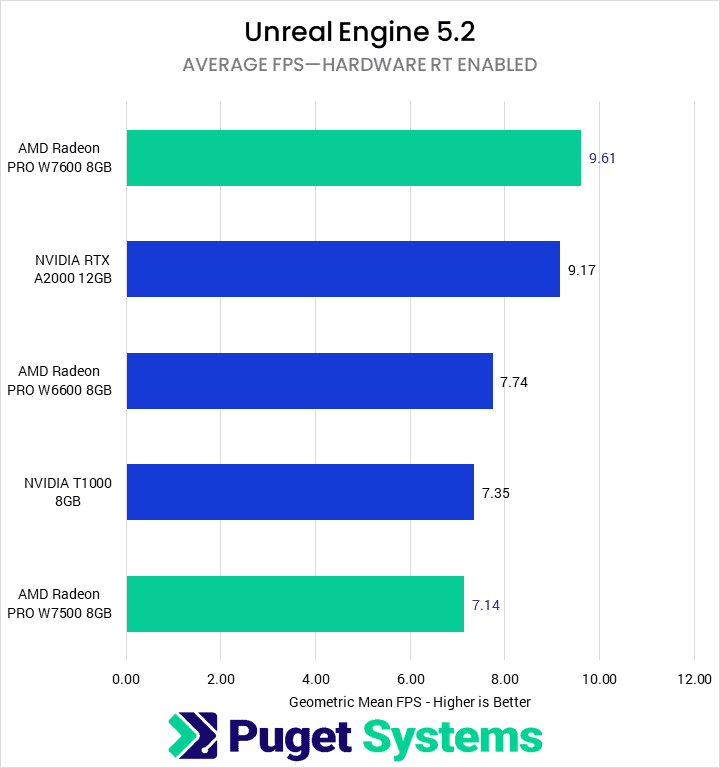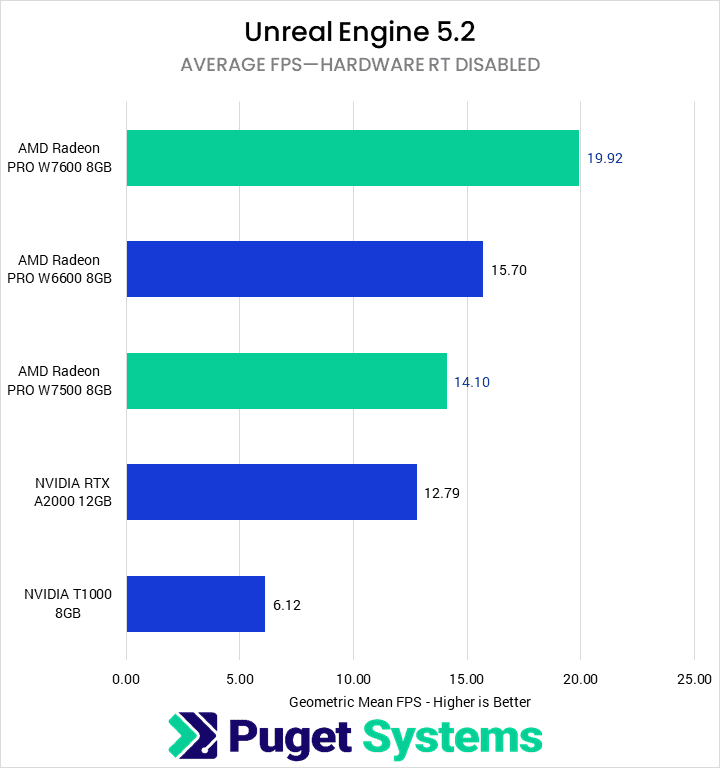Table of Contents
TL;DR: AMD Radeon PRO W7600 and W7500 for Content Creation
The AMD Radeon PRO W7600 and W7500 offer solid generational improvements over the W6600 and perform well compared to the NVIDIA RTX A2000 and NVIDIA T1000. In particular, the W7500 offers a compelling, all-around better alternative to the T1000.
In video editing, the W7600 matches the A2000 in Premiere Pro and slightly outperforms it in Davinci Resolve. The W7500 is even better, beating out the T1000 handily in both benchmarks. The AMD GPUs do particularly well in H.264/HEVC workloads, which are both common for users looking for a GPU of this class.
In rendering, the Radeon PRO cards are more of a mixed bag. They perform well at real-time rendering with Unreal Engine—particularly in rasterized tests—with a 20% overall advantage in fps. For offline rendering, though, NVIDIA continues to be dominant with their A2000, even when factoring in the new HIP-RT support in Blender.
Overall, whether the A2000 or W7600 is best will depend on your exact workflow, while the W7500 is the best value mid-range professional GPU available.
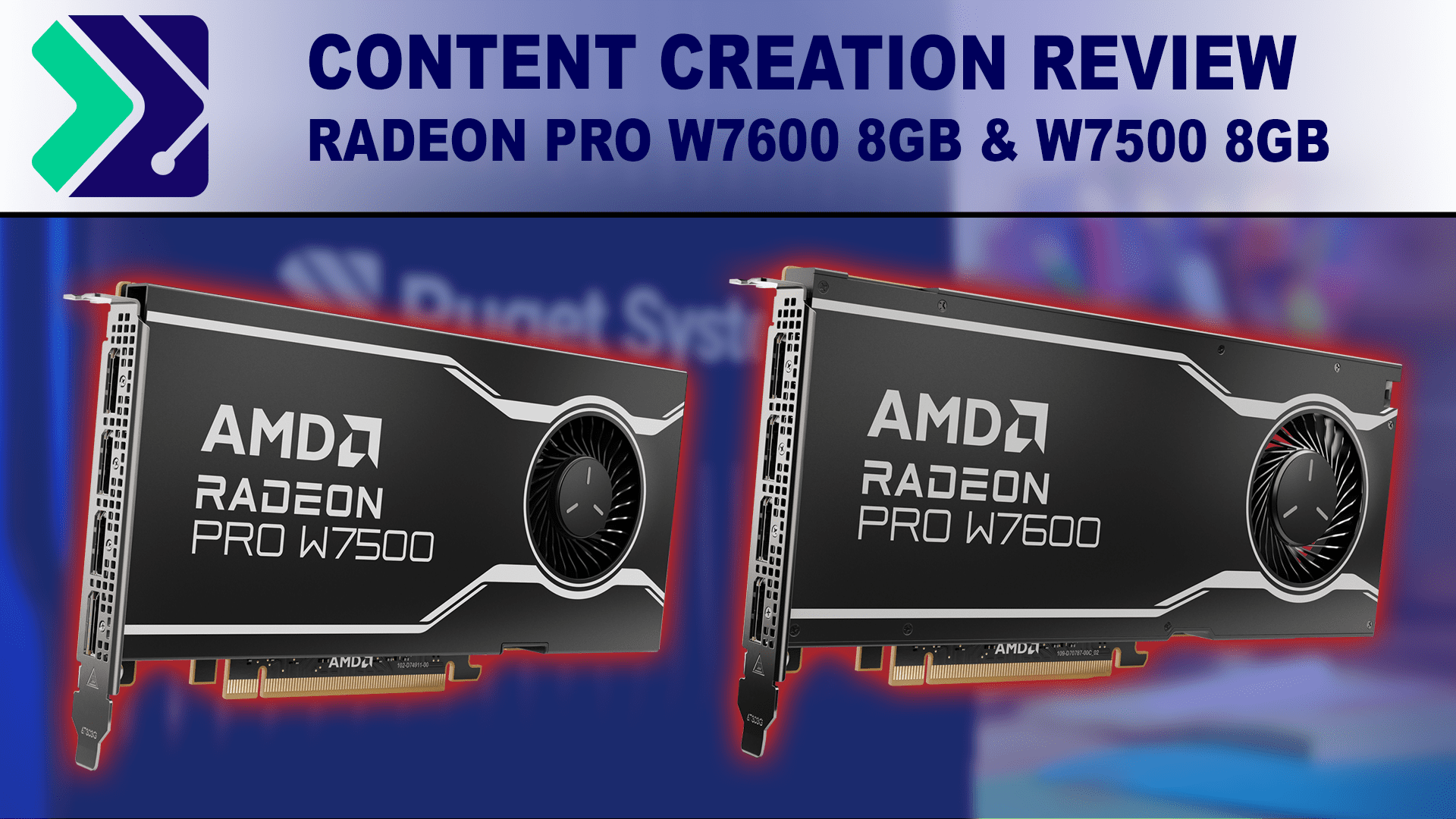
Introduction
The AMD Radeon PRO W7600 and W7500 are the newest entries in AMD’s 7000 series of professional GPUs, slotting in alongside the Radeon PRO W7900 and W7800, and replacing the last-gen Radeon PRO W6600. These cards are built on the RDNA3 architecture and feature 8 GB of VRAM, up to 20 TFLOPS of single-precision performance, AMD’s next-gen encoding/decoding hardware, and support the latest DisplayPort 2.1 UHBR 10.
While the upfront cost of a GPU is always important, professional GPUs like the Radeon PRO RX W7600 or NVIDIA’s RTX A2000 are not as targeted for raw price-to-performance as are consumer GPUs like the RX 7600 XT or the RTX 3060. Although more expensive than their consumer counterparts, they have additional validation work put in to ensure device reliability and system stability, and they frequently have drivers which are certified in a variety of professional applications–with, for example, AMD advertising over 1700 professional certifications for their Radeon PRO professional graphics. Not everyone needs the features offered by this class of GPU, but there are many workflows where the higher upfront cost more than makes up for the potential loss due to downtime if using a consumer graphics processor.
AMD and NVIDIA have overlapping sets of professional GPU product lines including both current- and last-generation cards, but the most relevant ones have been included below:
| GPU | Price | Power | VRAM | Single-precision performance | Release Date |
|---|---|---|---|---|---|
| AMD Radeon PRO W6600 | $650 | 130 W | 8 GB | 10 TFLOPS | June 2021 |
| AMR Radeon PRO W7600 | $600 | 130 W | 8 GB | 20 TFLOPS | Aug. 2023 |
| NVIDIA RTX A2000 | $580 | 70 W | 12 GB | 8 TFLOPS | Nov. 2021 |
| AMD Radeon PRO W7500 | $430 | 70 W | 8 GB | 12 TFLOPS | Aug. 2023 |
| NVIDIA T1000 | $400 | 50 W | 8 GB | 2.5 TFLOPS | May 2021 |
Although the Radeon PRO W7600 features a large increase in single-precision performance over the Radeon PRO W6600, it otherwise looks to be a straightforward replacement for the W6600 with the same power draw and VRAM for a slightly lower MSRP. The Radeon PRO W7500 lacks a last-generation counterpart–instead being a replacement for the 2020 Radeon Pro W5500–but looks to be a lower-power and lower-performance alternative to the W6600. Notably, the W7500 has the same 8 GB of VRAM as the W7600, while lacking the need for a supplementary power connector as it only draws up to 70 Watts.
The nearest competitors from NVIDIA for these cards are the RTX A2000 12GB and the T1000 8GB. Doing price comparisons for the NVIDIA cards is difficult as there is no published MSRP/SEP, so we pulled the prices from the current pricing on B&H and Newegg via PCPartPicker. As pricing can fluctuate dramatically over time, and professional GPUs are most frequently bought as part of a whole system, we will not be focusing too much on exact pricing in this article.
The big takeaway is that from a pricing perspective, the main comparisons we will be making are the AMD Radeon PRO W7600 vs NVIDIA RTX A2000 and the AMD Radeon PRO W7500 vs NVIDIA T1000.
Test Setup
Test Platform
| CPU: AMD Threadripper PRO 5975WX 32-Core |
| CPU Cooler: Noctua NH-U14S TR4-SP3 (AMD TR4) |
| Motherboard: ASUS Pro WS WRX80E-SAGE SE WIFI |
| RAM: 8x Micron DDR4-3200 16GB ECC Reg. (128GB total) |
| GPUs: AMD Radeon PRO W7600 AMD Radeon PRO W7500 AMD Radeon PRO W6600 NVIDIA RTX A2000 NVIDIA T1000 |
| PSU: Super Flower LEADEX Platinum 1600W |
| Storage: Samsung 980 Pro 2TB |
| OS: Windows 11 Pro 64-bit (22621) |
Benchmark Software
| Premiere Pro 23.5 PugetBench for Premiere Pro 0.98 |
| After Effects 23.5 PugetBench for After Effects 0.95.6 |
| Unreal Engine 5.2 |
| DaVinci Resolve 18.5 PugetBench for DaVinci Resolve 0.93.2 |
| Blender 3.6.0 |
In order to test the AMD Radeon PRO W7000 Series of graphics cards, we will be using the AMD Threadripper PRO 5975WX 32-Core CPU. Although we expect most users will be pairing these cards with a more price-conscious CPU platform, for the purposes of review we want to minimize CPU bottlenecks for our GPU testing; the 5975WX is one of our fastest platforms. In addition, this is the platform we use for all of our GPU testing, which makes the results more comparable with previous articles such as our Radeon PRO W7900/W7800 post.
We will use many of our PugetBench series of benchmarks, focusing on those that stress GPUs. Most of these benchmarks include the ability to upload the results to our online database, so if you want to know how your system compares, you can download and run the benchmark yourself. We have also included a GPU Rendering and Unreal Engine benchmark.
Video Editing: DaVinci Resolve Studio
Starting off with DaVinci Resolve, AMD gets an early win with the Radeon PRO W7600 beating the NVIDIA RTX A2000 by about 8%, and the W7500 beating the T1000 by a much larger 37%, in the GPU Effects portion of our benchmark. This is specifically looking at GPU-heavy tasks like OpenFX and noise reduction, however, which is probably not something you will want to do a lot with any GPU of this level.
In terms of overall performance in Resolve (chart #2), the W7600 and A2000 perform almost identically to each other, while the W7500 keeps a solid 26% lead over the NVIDIA T1000. This largely holds true for other specific aspects of Resolve such as H.264/HEVC performance (chart #3), and performance for RAW codecs like RED and BRAW (chart #4).
All-in-all, the Radeon PRO W7600 and W7500 fare very well in DaVinci Resolve, with the W7500 holding a significant lead over NVIDIA. We will note that due to the nature of these cards, we would recommend them only if you are working with lightweight projects. This could be CPU-centric codecs like ProRes or DNx or lower bitrate H.264/HEVC media—not anything using a lot of OpenFX or noise reduction. As good as the W7600/W7500 are, you likely want a more powerful GPU like the Radeon PRO W7800, W7900, or the NVIDIA equivalent for any GPU-heavy workflows.
Video Editing: Adobe Premiere Pro
Adobe Premiere Pro is similar to DaVinci Resolve in many ways but has a few small twists. Starting again with the GPU Effects score, the Radeon PRO W7600 and RTX A2000 scored within a percent of each other, and the Radeon PRO W7500 scored 28% higher than the T1000. This is slightly lower than what we saw in Resolve, but still a strong showing from AMD: especially from the W7500.
Overall in Premiere Pro, the W7600 and A2000 are on par, and the W7500 maintains about an 11% lead. A lot of Premiere Pro is CPU-bound, but for most people, this is likely going to be the most accurate representation of the relative performance you can expect in your day-to-day work.
An interesting area in Premiere Pro to examine in this case are performance with different types of GPU-accelerated codecs. Of the codecs we test, H.264/HEVC, which utilizes the GPU for hardware-accelerated encoding and decoding, shows the largest difference in score. Here, the W7600 and W7500 outperform the NVIDIA RTX A2000 and T1000 by 20% and 30%, respectively.
In large part because of this higher H.264/HEVC performance, we would rate AMD as the better professional GPU choice for basic Premiere Pro usage. We wouldn’t recommend this class of GPU for anything heavy, but H.264 and HEVC are very common codecs, and an additional 20-30% performance for them can make a big difference.
Game Dev/Virtual Production: Unreal Engine
There are very few cases for Unreal Engine where a professional-grade GPU is helpful over a consumer GPU. Usually, it is either because of the large VRAM pools required or because of features such as Sync to power large LED volumes. However, neither of these are present on the new AMD GPUs: the VRAM buffer is only 8GB, which is very low for this workflow, and Sync technology is only available on NVIDIA cards.
Our test scenes are demanding, but the new Radeon PRO W7600 outperforms the NVIDIA A2000 by roughly 20% on average. This is primarily due to a considerable lead when hardware ray tracing is disabled. However, in projects that do support hardware RT, they are within a few percent of each other.
The W7500 is about as fast as the NVIDIA T1000 when ray tracing is enabled but twice as fast when it is disabled. This really shows the limitations of the Turing architecture from NVIDIA.
However, it is important to note that none of these tests produce usable frame rates; anyone considering these cards for Unreal will need to lower graphical settings and keep projects on the lighter side. Ideally, we recommend a more powerful GPU if you are working with Unreal Engine.
GPU Rendering: Blender
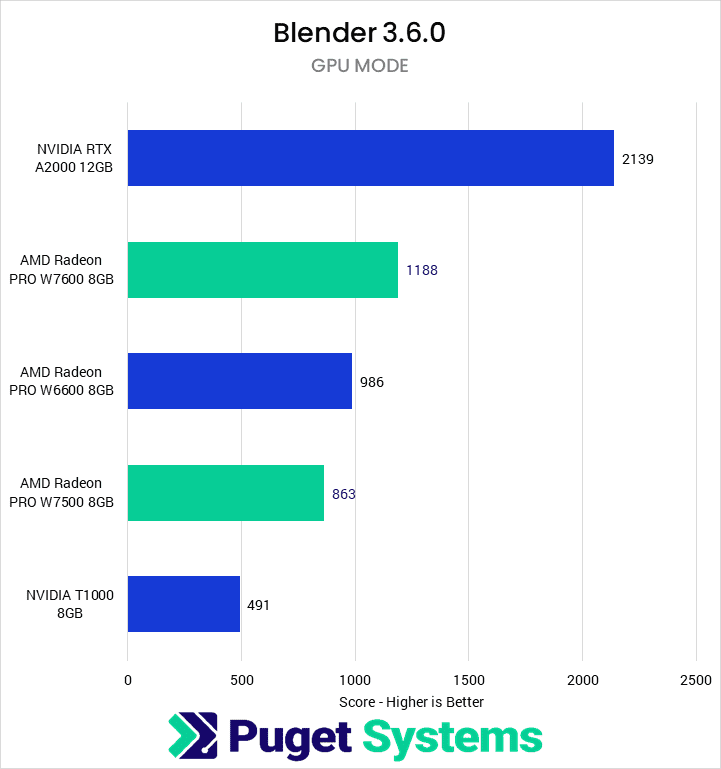
Turning to Blender, we see NVIDIA’s strong lead in GPU rendering. Like Unreal Eninge, this isn’t necessarily the class of card someone would be looking at for rendering, but it is worthwhile to investigate potential capabilities. Although it is two years old, NVIDIA’s RTX A2000 is nearly twice as fast as the new AMD cards. Blender’s benchmark does not yet take into account any RT cores in AMD’s cards. However, based on our testing, HIP-RT support will improve performance anywhere from 10-25%—still not enough to get close to NVIDIA.
AMD’s Radeon PRO W7500 does much better when compared to the NVIDIA T1000. This isn’t too surprising as the T1000 is based on the Turing architecture, which was NVIDIA’s first attempt at ray tracing cores four years ago.
How Well Do the AMD Radeon PRO W7600 and W7500 Perform for Content Creation?
Mid-range professional GPUs—$350-$950—make up the largest segment of professional GPU sales but have seen relatively little in terms of new products as manufacturers have updated their product lines. For example, NVIDIA still sells the T1000, which is based on a nearly 5-year-old architecture. The AMD Radeon PRO W7600 and W7500 offer a current-generation entry into this space, with modern features like DisplayPort 2.1, AV1 encoding, and AI Accelerators. They do carry the associated professional-GPU price tag with them, but for many pro workflows, the reliability and stability are worth the extra cost.
For video editing tasks, the AMD Radeon PRO W7600 and W7500 can be a great choice if you are looking for a basic professional GPU for relatively light workloads. The 8GB of VRAM is plenty for HD and simple UHD/4K projects, and can even handle moderate amounts of GPU-accelerated effects. Compared to NVIDIA, the Radeon PRO W7600 was on par with the NVIDIA RTX A2000 in most of our tests but pulled ahead for both GPU-accelerated effects in DaVinci Resolve (by 8%) and H.264/HEVC workloads in Premiere Pro (by 20%). The fact that the W7600 has less RAM and a higher power draw than the A2000 evens things out a bit, but for most users, we still give AMD the edge for this type of workflow.
The Radeon PRO W7500, on the other hand, gives AMD a much clearer win over the NVIDIA T1000 with the W7500 consistently being anywhere from 10% to nearly 40% faster. Even better for AMD, the larger wins came in critical areas such as H.264/HEVC performance and performance when processing GPU-accelerated effects.
When it comes to rendering, both real-time with Unreal Engine and offline with Blender, none of the GPUs tested are particularly well-suited to this workflow. The low-performance and low-VRAM pools make them relatively slow without offering any of the typical benefits of higher-end professional GPUs for these tasks. Nevertheless, these benchmarks can show interesting differences between NVIDIA and AMD.
In Unreal Engine, AMDs W7600 and W7500 have a strong performance lead over the comparable NVIDIA cards in rasterized performance. In particular, the W7500 does very well, outperforming even the A2000. With ray-tracing enabled, their performance advantage shrinks considerably, with the W7600 just barely beating out the A2000, and the W7500 performing the worst of any of the GPUs tested.
Blender is a particularly bad benchmark for AMD, in part due to the lack of HIP-RT support within the benchmark. However, this feature currently only adds 10-25% additional performance for AMD cards, which is insufficient to close the advantage NVIDIA has. Here, the A2000 offers nearly twice the performance of the W7600, which is itself 25% faster than the W7500. Both cards do both handily beat the NVIDIA T1000, though, which struggles in this benchmark.
Overall, the new AMD Radeon PRO W7600 and W7500 offer a solid improvement over the last-generation W6600, and it is good to see that the lower-priced 500 class of AMD’s line is getting refreshed; until now, the only card in that space was the 3-year-old W5500. The cards also offer a solid alternative to NVIDIA’s similarly-priced professional GPUs, with performance largely on par or exceeding them. The W7600 is the less exciting of the two, as it has an SEP slightly above the A2000’s average market price, while also offering less VRAM and higher power draw—the A2000 lacks a supplementary power connector. Which of these is better will depend a lot on what the target use case is.
In contrast, the W7500 offers a marked upgrade in performance over the T1000 for only a slight price bump. It isn’t suited for heavy GPU workflows, but if you need a card capable of the occasional GPU-accelerated task, it is a much more attractive option than the NVIDIA T1000. NVIDIA has been dominant in the content creation space for a long time, so it is good to see that AMD is continuing to challenge them with its Radeon PRO W7000 series of graphics cards.
If you need a powerful workstation to tackle the applications we’ve tested, the Puget Systems workstations on our solutions page are tailored to excel for various software packages. If you prefer to take a more hands-on approach, our custom configuration page helps you to configure a workstation that matches your exact needs. Otherwise, if you would like more guidance in configuring a workstation that aligns with your unique workflow, our knowledgeable technology consultants are here to lend their expertise.


